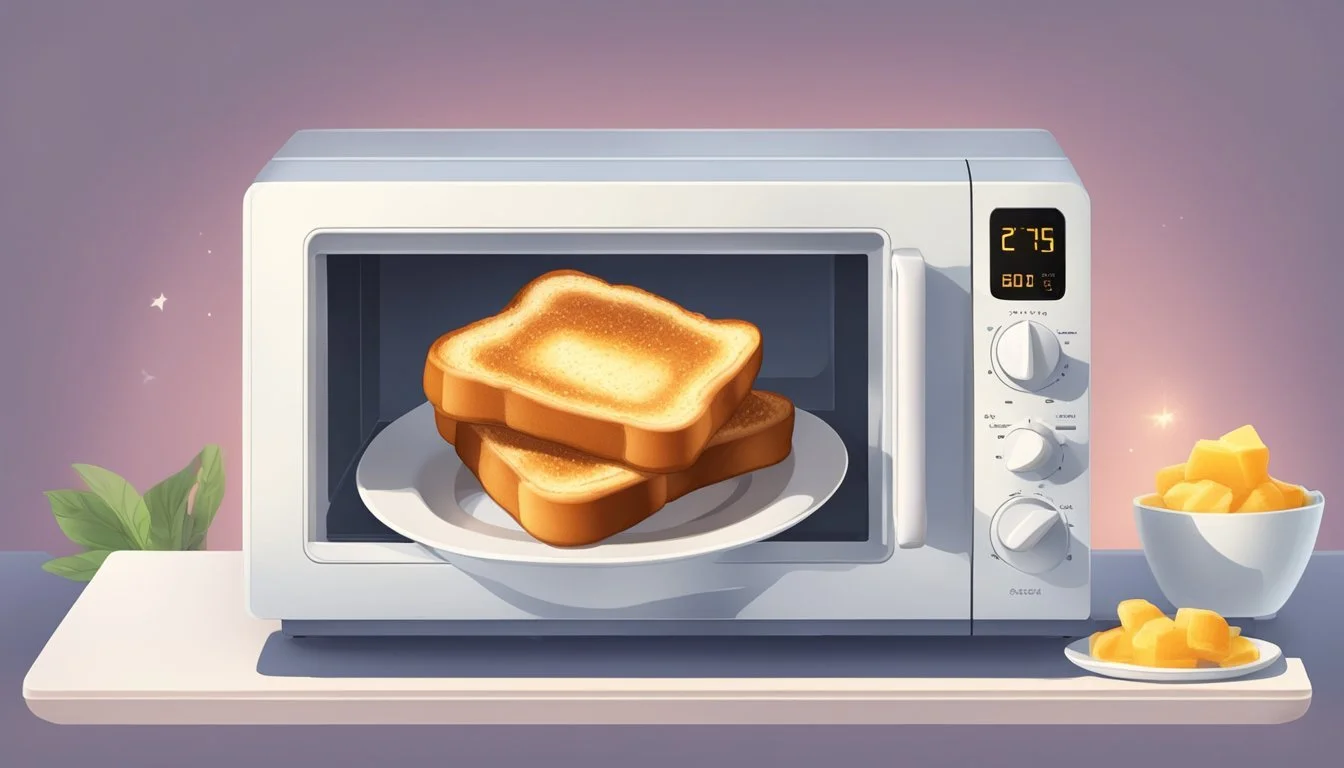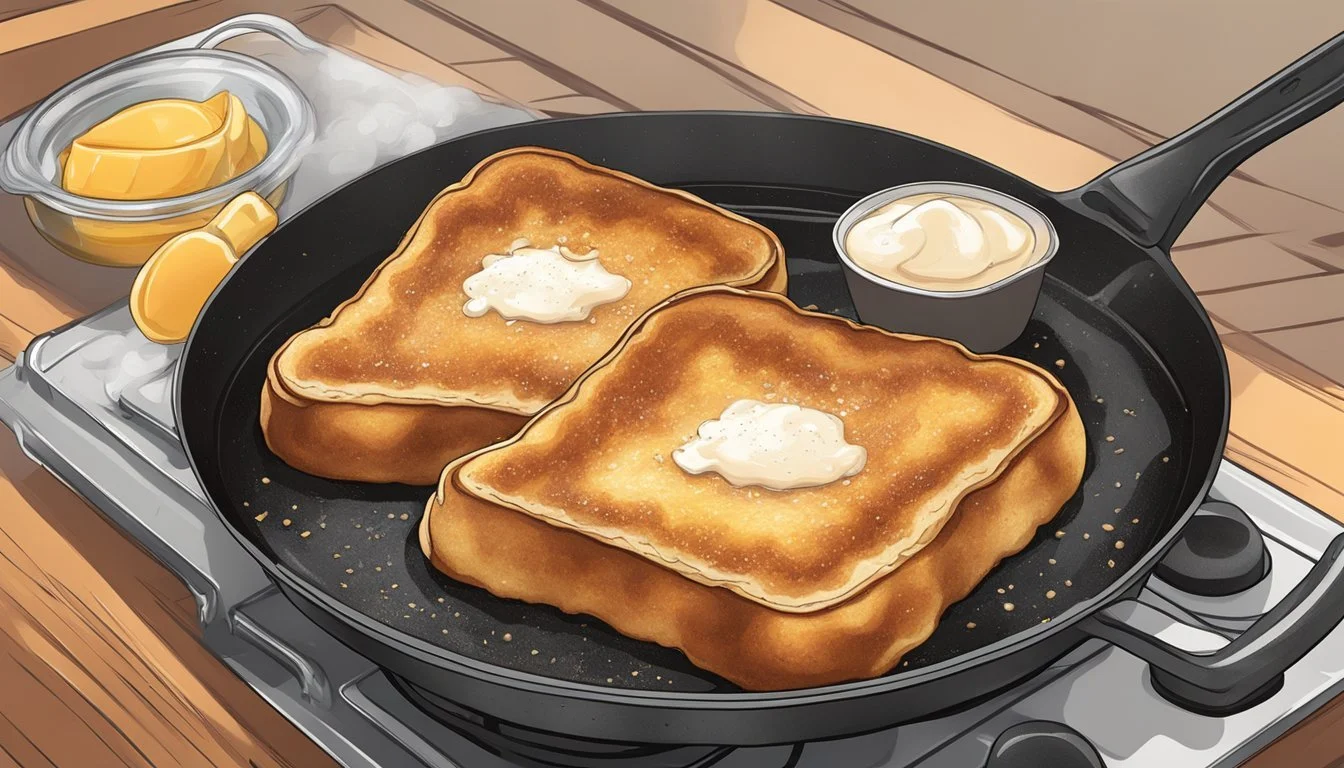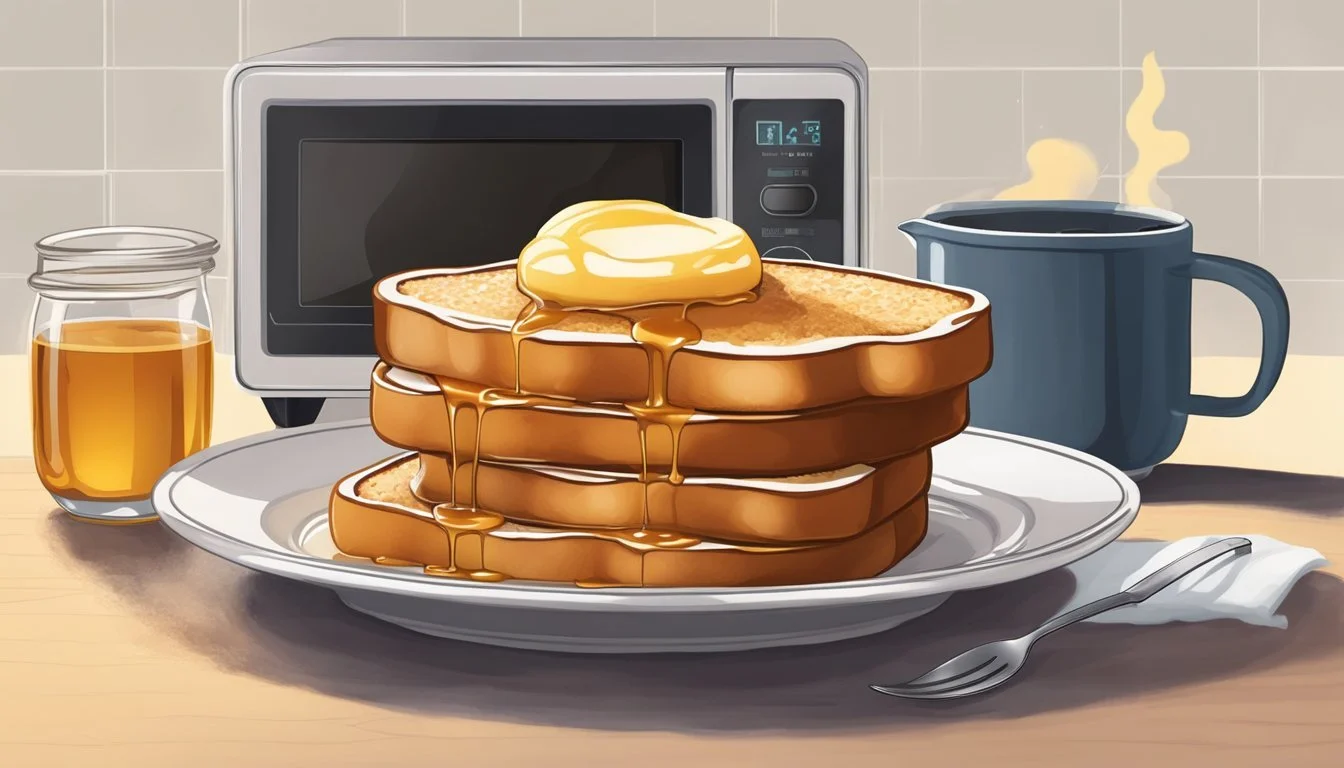Best Way to Reheat French Toast
Ensuring a Fluffy Breakfast Treat
Reheated French toast can be just as sumptuous as when it was first made if done correctly. The key concern for many people is maintaining the dish’s original fluffiness and avoiding a soggy or dry texture. As French toast typically consists of bread that's been soaked in a mixture of eggs and milk and then cooked until golden brown, the reheating process needs to meticulously preserve the delicate balance of its crisp exterior and moist interior.
Several methods exist for bringing French toast back to life, each with its own merits. Using an oven can ensure even heating and restore much of the toast’s original texture. A skillet, on the other hand, offers a quick and controlled approach that can re-crisp the edges effectively. Air fryers have also grown in popularity for reheating food, and they can provide a quick and convenient option without the need for preheating.
Selecting the best method depends on the equipment available and personal preference. It also involves a few critical steps, such as the right temperature setting and timing, to rejuvenate the French toast while preserving its desired fluffiness. Each of these methods can achieve the goal of serving a warm and fluffy French toast, rivaling its freshly made counterpart as long as proper technique is applied.
Fundamentals of French Toast
Creating the perfect French toast begins with a balance of simple yet quality ingredients and precise preparation techniques. These are essential to ensure the French toast retains its signature fluffy texture and rich flavor.
Ingredients for the Perfect French Toast
The cornerstone of any French toast recipe is bread. A thick, sturdy bread like brioche or challah is ideal because it can absorb the egg mixture without falling apart. The egg mixture, typically made of eggs, milk or cream, provides the base for the French toast's custardy interior. Additions such as cinnamon and vanilla extract contribute to the distinct flavor profile that makes French toast so beloved. For extra decadence, a pinch of sugar can be whisked in as well.
The following ingredients are central to most French toast recipes:
Bread: Brioche or Challah, sliced 3/4 to 1 inch thick
Eggs: Usually one egg per two slices of bread
Milk or Cream: To thin the egg mixture
Cinnamon: Depends on personal preference
Vanilla Extract: A teaspoon for flavor enhancement
Sugar: Optional, for sweetening
Basics of French Toast Preparation
The process of making French toast involves dipping each slice of bread into the egg mixture, ensuring both sides are well-coated. The bread should soak just long enough to become saturated with the mixture but not so long that it starts to disintegrate. The soaked slices are then cooked on a heated pan over medium heat until the exterior is golden brown and the interior is cooked through but still moist.
One should follow these basic steps to achieve the ideal texture and flavor:
Whisk together eggs, milk or cream, cinnamon, vanilla, and optional sugar into a smooth mixture.
Dip bread slices in the egg mixture, soaking each side for a few seconds.
Cook the soaked bread on a preheated pan or griddle until golden brown on both sides.
Properly prepared French toast is typically finished with a selection of toppings, such as fresh fruit, syrup, or a dusting of powdered sugar, which can be tailored according to individual recipes and taste preferences.
Storage Solutions for French Toast
Effectively storaging French toast ensures it retains its delicious taste and texture. This section elucidates the best methods for keeping French toast fresh before its next serving.
Proper Storage Techniques
One should store French toast in an airtight container or wrap it tightly in aluminum foil or plastic wrap. This approach keeps moisture in and prevents the toast from drying out. The refrigerator is ideal for short-term storage, with French toast maintaining its quality for up to two days. For best results, one might layer the French toast with wax paper to prevent slices from sticking together.
Freezing and Defrosting French Toast
When freezing French toast, it is advisable to flash freeze the slices on a baking sheet for about two hours first. Once frozen, the individual pieces can be transferred to a freezer bag or wrapped in foil. For the utmost freshness, a vacuum sealer can remove air, extending the storage life of the toast significantly in the freezer. To defrost, one should place the frozen French toast in the refrigerator overnight or reheat it directly from the freezer by using an oven or toaster to preserve its fluffiness and warmth.
Reheating French Toast for Optimal Fluffiness
When reheating French toast, maintaining its fluffy texture is paramount. Each method influences the toast's final quality, and careful application ensures even heating and optimal fluffiness.
Overview of Reheating Methods
Reheating methods vary in effectiveness for restoring the lush fluffiness of French toast. The oven and skillet methods are superior for even heating, while microwave, toaster oven, and air fryer methods cater to speed and convenience.
Oven Reheating Guide
Preheat the oven to 400 degrees Fahrenheit.
Grease a baking sheet or line with parchment paper.
Place French toast slices on the sheet without overlapping.
Heat for 3-4 minutes, flip, and continue for another 3-4 minutes.
The oven method ensures even heating and preserves texture.
Stovetop Skillet Method
Heat a skillet over medium heat and add a small amount of butter or oil.
Lay the French toast in the skillet, ensuring not to overcrowd.
Cook for 2-4 minutes per side until heated thoroughly.
Skillets facilitate quick reheating while adding a slight crispy exterior.
Toaster Oven Approach
Set toaster oven to 350 degrees Fahrenheit.
Place the French toast on the toaster oven rack or on a baking sheet.
Heat for about 3 minutes, then check to prevent over-browning.
Toaster ovens are excellent for quick reheating, though monitoring is crucial.
Microwave Heating Instructions
Place French toast on a microwave-safe plate.
Heat using 20-second intervals, checking after each to avoid sogginess.
While not ideal for fluffiness, microwaves offer the fastest reheating option.
Air Fryer Use
Preheat the air fryer to 365 degrees Fahrenheit.
Arrange French toast in the basket in a single layer with space in between.
Heat for 2-3 minutes, checking for desired warmth and texture.
Air fryers can reheat French toast rapidly with a slight crispiness.
Each method's instructions are framed to maintain the French toast's original fluffy texture. Ensuring even heat and avoiding overheating are key factors across all reheating methods.
Ensuring the Perfect Crispiness
Achieving the perfect crispiness in reheated French toast lies in the method and tools one uses during the reheating process. The goal is to restore the toast's warm, crunchy exterior without over-drying the interior.
Baking Sheet and Foil Use
Using a baking sheet lined with aluminum foil or parchment paper is a straightforward method to keep French toast crispy. The foil reflects heat, promoting an even crisping process, while parchment paper minimizes sticking. Here’s how to effectively use these tools:
Preheat the oven to 400 degrees Fahrenheit.
Line a baking sheet with aluminum foil or parchment paper, avoiding wax paper as it can melt or burn.
Grease the foil or paper with non-stick spray or a light brushing of butter to prevent sticking.
Arrange the French toast slices in a single layer, leaving space between them for heat circulation.
Reheat French toast for 6 to 8 minutes; flip each piece halfway through to ensure even crispiness.
Wire Rack Technique
For the ideal texture, reheating on a wire rack placed over a cookie sheet captures the essence of crispiness effectively. The air circulates freely around the bread, preventing the bottom from becoming soggy. To use this technique:
Preheat the oven to 400 degrees Fahrenheit.
Set a wire rack on top of a baking or cookie sheet.
Lay the French toast slices on the wire rack, ensuring none are touching.
Heat the French toast for roughly 6 to 8 minutes, turning halfway through just as if using a baking sheet and foil.
By adhering to these methods, one can expect French toast that is as crispy as desired without compromising its delightful fluffiness.
Serving and Presentation
Serving French toast at its best involves not just reheating it to the perfect temperature, but also presenting it with the right toppings and keeping it warm until it reaches the table.
Suggested Toppings and Accompaniments
A variety of toppings can elevate the flavors and textures of French toast. Here's a selection that pairs beautifully with the golden brown exterior and fluffy interior:
Fresh Fruit: Slices of strawberries, bananas, or a mix of berries add a refreshing touch.
Whipped Cream: A dollop of whipped cream can provide a creamy contrast.
Maple Syrup: Drizzle maple syrup for a classic, sweet enhancement.
Powdered Sugar: A light dusting of powdered sugar gives a touch of elegance.
Cinnamon Sugar: Sprinkle cinnamon sugar for a warm, spiced flavor.
Peanut Butter: A spread of peanut butter adds richness and a nutty taste.
Keeping French Toast Warm
To ensure French toast retains its ideal texture before serving:
Preheat an oven to a low setting and place French toast in a single layer on a baking sheet.
Cover with aluminum foil to trap heat without causing sogginess.
Serve promptly after reheating to maintain the crispy exterior and warm interior.
Common Mistakes and Troubleshooting
When reheating French toast, the goal is to maintain its delightful texture. This section explores how to avoid common reheating mistakes that can lead to less-than-perfect results.
Avoiding Soggy Results
To prevent French toast from becoming soggy during reheating:
Preheat the Oven: Always start with a preheated oven to ensure even heating.
Baking Sheet Setup: Use a greased baking sheet and place the French toast slices in a single layer with space in between.
Oven Temperature: An oven temperature of 400 degrees Fahrenheit is ideal to prevent sogginess.
Flipping: Halfway through reheating, flip each piece to allow both sides to crisp up evenly.
It's important to avoid covering the French toast with foil in the oven, as this can trap steam and moisture, contributing to sogginess.
Fixing Leftover Textural Issues
For leftover French toast that has lost its original texture:
Skillet Method: Heat a skillet to medium and melt some butter. Cook the French toast for 1-2 minutes on each side until it regains a bit of crispiness.
Oven Reheating: If using an oven, watch the toast carefully, turning after about 4 minutes to ensure it crisps on both sides. Adjust time as needed if starting from frozen.
One common mistake with leftovers is applying too much heat, which can dry out the French toast. Gentle reheating is key to restoring texture without further degrading quality.
Additional Tips and Final Thoughts
To ensure quality results, it is important for the reader to consider the subtle nuances that affect the flavor and texture of reheated French toast, as well as the types of equipment that can facilitate even heating.
Enhancing Flavor and Texture
To enhance the flavor and texture of French toast when reheating, one can take steps beyond simple warming.
Flavor: To infuse additional flavor into their French toast, readers should consider adding a pinch of cinnamon or vanilla extract to the egg mixture before the initial cooking. When reheating, a pat of butter can be added to bring back the richness. For a fresh twist, one can also serve the toast with fresh berries, like strawberries or blueberries, to complement the dish.
Texture: To preserve its signature fluffy interior, it is crucial not to overheat the French toast. For brioche or similarly dense breads, a brief exposure to high heat can help restore the outer crispness. To maintain even heating and optimal texture, one should ensure that there is adequate space between slices during the reheating process.
Equipment and Tool Recommendations
The proper equipment contributes greatly to the success of reheating French toast.
Even Heating: An oven or toaster oven, preheated to a moderate temperature (~350°F to 400°F), is recommended for even heating. If one opts to use a skillet, it should be heated over medium heat to prevent burning while still achieving a crisp exterior.
Guide to Equipment:
Oven: Ideal for large batches, preheated to 350°F-400°F, bake for 6-8 minutes, flip halfway.
Skillet: For individual servings, medium heat, 2-4 minutes per side, consider a light butter coating.
Air Fryer: For a quick method, set to 365°F, cook for 2-3 minutes.
Toaster Oven: Set to medium-low, duration varies by desired crispness.
In summary, for an optimal reheating experience, one should be mindful of incorporating techniques that enhance taste and texture, while also selecting the appropriate tools that promote even heating.
Comparison With Other Breakfast Foods
When evaluating the best methods to reheat French toast, it's essential to consider how this popular breakfast item compares to others like pancakes and casseroles (What wine goes well with casseroles?) in terms of reheating techniques.
French Toast vs. Pancakes
Pancakes, like French toast, are a staple in both breakfast and brunch menus. The primary difference in reheating comes down to texture preferences:
French Toast: It should be reheated to maintain its custardy interior and crisp exterior, which can be achieved by using an oven or a skillet.
Pancakes: These tend to fare well when reheated in a microwave, which retains their softness but may lack the crisp edge that a skillet would provide.
In terms of reheating time, pancakes typically require less time due to their thinner profile, whereas French toast, being thicker and denser, may need a few extra minutes to ensure even warmth throughout.
French Toast vs. Casserole
Casseroles present a different challenge when it comes to reheating. Unlike single servings of french toast, a casserole is a baked ensemble that could consist of layers and a variety of ingredients:
French Toast: Single slices are easier to reheat uniformly, and recommended methods include the oven or a skillet to crisp up the exterior while keeping the inside moist.
Casserole: This often requires reheating in an oven to ensure that the core temperature is adequate for all the layered ingredients. Microwaving can be used but might result in uneven heating.
For those who value a crisp topping, often seen in breakfast casseroles, an oven reheat is the best parallel to revitalizing French toast to its original glory.







